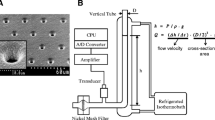Summary
An automated filtration technique has been used to investigate the effect of dipyridamole (DP) on red blood cell deformability in patients identified as having rigid red cells. They were patients on haemodialysis (HD) for chronic renal failure (n=18), patients with peripheral vascular disease (PVD, n=23) and controls (hospital out-patients, n=33). Leucocytes and platelets were removed from heparinised blood by filtration through Imugard wool. Washed red cell suspensions in buffer at 5% haematocrit, without or with 5 μM DP, were filtered through Nuclepore Hemafil Membranes with 4.7 μm pores. The initial steady state relative filtration pressure (iRFP) was used to assess cell deformability. A low iRFP value reflects increased deformability and vice versa. The mean iRFP values were 0.33, 0.393 and 0.403 for controls, PVD and HD patients respectively, indicating that the red cells in the two groups of patients were significantly more rigid. DP reduced the iRFP to 0.266, 0.278 and 0.263 for controls, PVD and HD patients respectively.
The results suggest that DP may be beneficial when red cell rigidity contributes to impaired microvascular perfusion.
Similar content being viewed by others
References
Bunag RD, Douglas CR, Imai S, Berne RM (1964) Influence of pyrimidopyrimidine derivative on deamination of adenosine by blood. Circ Res 15: 83–88
Asano T, Ochiai T, Hidak H (1977) Selective inhibition of separate forms of platelet cyclic nucleotide phosphodiesterase by platelet aggregation inhibitors. Mol Pharmacol 13: 400–406
Saniabadi AR, Tomiak R, Lowe G et al. (1989) Dipyridamole inhibits red cell-induced platelet activation. Atherosclerosis 66: 175–180
Ferber E, Munder PG, Fischer M (1966) Wirkung von Dipyridamole und von Prednisolon auf Lysophospholipase von Erythrocyten. Biochem Z 344: 217–220
Fuster V, Badimon L, Badimon J et al. (1987) Drugs interfering with platelet functions: mechanisms and clinical relevance. In: Verstraete M, Vermylen J, Lijinen R, Arnout N (eds) Thrombosis and haemostasis. Leuven University Press, Belgium, pp 349–418
Jacob HS, Amsden T (1971) Acute haemolytic anaemia with rigid red cells in hypophosphataemia. N Engl J Med 285: 1446–1450
Saniabadi AR, Fisher TC, Rimmer AR, Belch J, Forbes CD (1990) A study of the effect of dipyridamole on erythrocyte deformability using an improved filtration technique. Clin Haemorheol 10: 263–274
Reid HL, Barnes AJ, Lock PJ, Dormandy JA, Dormandy TL (1976) A simple method for studying erythrocyte deformability. J Clin Pathol 29: 855–858
Dormandy J (1985) Non-white cell clogging. In: Dormandy J (ed) Blood filtration and blood cell deformability. Martinus Nijhoff, Boston, pp 23–24
Lowe GDO (1985) Qualitative and quantitative effects of white blood cells in a positive pressure filtration system. In: Dormandy J (ed) Blood filtration and blood cell deformability. Martinus Nijhof, Boston, pp 18–19
Saniabadi AR, Fisher TC, Mclaren M, Belch J, Forbes CD (1991) Effect of dipyridamole alone and in combination with aspirin on whole blood platelet aggregation PGI2 generation and red cell deformability ex-vivo in man. Cardiovasc Res 25: 177–183
ICSH Expert Panel on Blood Rheology (1983) Guidelines for the measurement of blood viscosity and red cell deformability. Clin Haemorheol 6: 439–453
Skalak R (1985) Effect of white blood cells on filtration measurement. In: Dormandy J (ed) Blood filtration and blood cell deformability. Martinus Nijhoff, Boston, pp 13–14
Stuart J (1985) Effect of contaminating leucocytes on erythrocyte filtrability. In: Dormandy J (ed) Blood filtration and blood cell deformability. Nijhoff, Boston, pp 20–22
Chesbro JH, Fuster V, Elveback LR et al. (1983) Trial of combined warfarin plus dipyridamole or aspirin therapy on prosthetic valve replacement: danger of aspirin compared with dipyridamole. Am J Cardiol 51: 1537–1541
Weiss HJ (1982) Dipyridamole and other phosphodiesterase inhibitors. In: Weiss HJ (ed) Platelets pathophysiology and anti-platelet drug therapy. Liss, New York, pp 57–62
Weiss HJ, Toritto JT, Vicic WJ, Baumgartner HB (1981) Effect of aspirin and dipyridamole on the interaction of platelets with subendothelium. Thromb Haemostas 45: 136–141
Reinhart WH, Chien S (1986) Red cell rheology in stomatocyte-echinocyte transformation: roles of cell geometry and cell shape. Blood 67: 1110–1118
Hattorie A, Watanabe T, Izumi T (1978) Scanning electron microscopy study on haemostatic reaction, mural thrombus after the remmoval of endothelium, site of fibrin formation and micro-haemolysis. Arch Histol Jap 41: 205–227
Fortier NM, Snyder LM, Garveil F, Kiefer C, Mohandas N (1988) The relationship between in vivo haemoglobin skeletal protein complex and red cell membrane rigidity. Blood 71: 1427–1431
Harker LA, Kadatz RA (1983) Mechanisms of action of dipy ridamole. Thromb Res [Suppl IV]: 39–46
Hellem AJ (1960) The adhesiveness of human blood platelets in vitro. Scand J Clin Lab Invest 12: [Suppl 51] 1–117
Born GVR (1985) Haemorheological influences on platelet thrombogenesis. Clin Haemorheol 5: 89–96
Sullivan JM, Harken OE, Corlin R (1968) Pharmacological control of thromboembolic complications of cardiac valve replacement. N Engl J Med 279: 576–580
Kamitsuiji H (1979) Clinical complications in long term period after prosthetic valve replacement for acquired valvular heart disease. Med J Kobe Univ 4: 275–286 (Abstracts)
Author information
Authors and Affiliations
Rights and permissions
About this article
Cite this article
Saniabadi, A.R., Fisher, T.C., Lau, C.S. et al. Dipyridamole increases human red blood cell deformability. Eur J Clin Pharmacol 42, 651–654 (1992). https://doi.org/10.1007/BF00265931
Received:
Accepted:
Issue Date:
DOI: https://doi.org/10.1007/BF00265931




